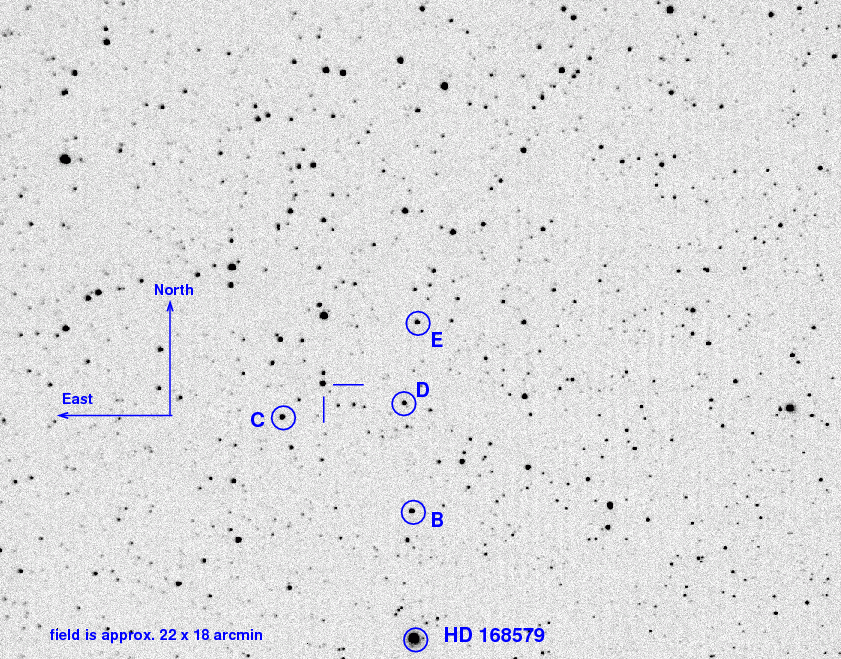
On the night of Aug 14/15, 2019, through clear but moon-lit skies, I acquired a set of observations of the likely black-hole system MAXIJ1820+070, (also known as ASASSN-18ey ).
These are my first observations of this system since UT March 26, 2019. I decided to switch back to it after hearing of the system's resurgence in brightness in both optical and X-rays:
As you'll see, the system to too faint for me to measure well through a V-band filter. I'll switch to unfiltered measurements in the future.
The main setup was:
Notes from the night:
The problems were many tonight. I had to disconnect the control cables from the filterwheel (leaving it fixed in the "V" position) in order to free one USB port on the tower's front panel; I connected the guider camera's USB cable to this port, as it was failing when plugged into the USB hub.
Note: must replace USB hub
The MaximDL process survived the switch to remote desktop, but later froze around 11:13 AM = image 0064. It took about a half hour to recover from multiple freezes, and the guide camera was ill: MaximDL continued to read images from it, but complained with frequent error messages ("cannot initialize guide camera"); moreover, the guider's corrections did not seem to be sent to the telescope mount properly. I had to stop using the guider completely after about midnight.
This optical and X-ray and radio transient is likely a black hole accreting material at a higher-than-usual rate. It has been the subject of many observers over the past few months -- see the trail of telegrams that include
The object is located at
RA = 18:20:21.9 Dec = +07:11:07.3
A chart of the field is shown below. The size of the chart is about 22 by 18 arcminutes.
I've marked the location of several comparison stars, which also appear in light curves below. Stars C, D, and E are mentioned by the Tomoe Gozen team in ATel 11426, but all three are rather red, with (B-V) ranging from 1.14 to 1.37. Star B is one of the bluest nearby bright stars, with (B-V) = 0.52.
star UCAC4 B V ---------------------------------------------------- B 486-079513 12.975 12.454 C 486-079608 13.968 12.830 D 486-079523 14.637 13.272 E 487-077858 14.637 13.272 ----------------------------------------------------
I ran the camera at -20 C. Nothing out of the ordinary.

The sky value shows no clouds, but some minor blips due to the dome; I had to close the dome slit and re-open to switch the position of the lower panel.

Here's a record of the telescope's drift. As mentioned above, lots problems with the guider, and guiding was turned off after the break.

The number of objects detected -- I required 60 objects for an image to be included in the ensemble.

I used an aperture with radius 4.0 pixels.

I discarded images which had obvious trailed stellar images, and also images which were outliers in the "image adjustment" plot. (discarded a total of 133 of the 282 raw images).

Using aperture photometry with a radius of 4 pixels (binned 2x2, each pixel is 1.34 arcsec, so a radius of 5.4 arcsec), I measured the instrumental magnitudes of a number of reference stars and the target. Following the procedures outlined by Kent Honeycutt's article on inhomogeneous ensemble photometry, I used all stars available in each image to define a reference frame, and measured each star against this frame.
Sigma-vs-mag plots show that the floor was about 0.006 mag overall. I did NOT mark star "A" as variable in the ensemble.

Here are light curves of the variable and the field stars.

I used the UCAC value for the V-band magnitude of star "B" = UCAC4 486-079513 to shift the ensemble magnitudes to the standard V-band scale.
Here's a closeup on the variable. The scatter to too large to show any possible smooth variations.

You can download my measurements below. A copy of the header of the file is shown to explain the format.
# Measurements of MAXIJ1820+070 made at RIT Obs, UT 2019 Aug 15, # in fair conditions, # by Michael Richmond, # using Meade 12-inch LX200 and ATIK 11000. # Exposures 30 seconds long, V filter. # Tabulated times are midexposure (FITS header time - half exposure length) # and accurate only to +/- 1 second (??). # 'mag' is a differential magnitude based on ensemble photometry # using a circular aperture of radius 4 pix = 5.3 arcseconds. # which has been shifted so UCAC4 486-079513 has mag=12.454 # which is its V-band magnitude according to UCAC4. # # UT_day JD HJD mag uncert Aug15.09920 2458710.59920 2458710.60271 14.602 0.063 Aug15.09971 2458710.59971 2458710.60322 14.581 0.068 Aug15.10021 2458710.60021 2458710.60372 14.664 0.070
Last modified 8/15/2019 by MWR.